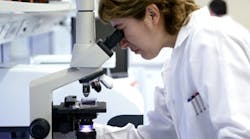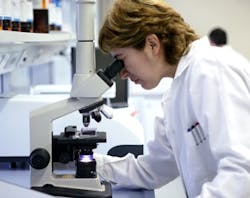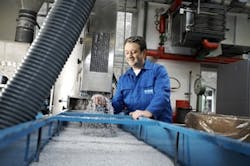Lifecycle analysis (LCA) promises to play an increasingly important role in decision-making in the chemical industry. Already, major companies like Dow, Air Products and BASF rely on LCA to evaluate the sustainability of their products and processes.
LCA involves an integrated evaluation from raw materials production through manufacture, distribution, use and disposal of products, as well as any other issues caused by a product's existence. The key point is to remember that LCA is a continuum, says Dr. Anne Wallin, LCA expert with Dow, Horgen, Switzerland. It clearly fits in well with the Midland, Mich.-based company's ambitious sustainability goals (see, "We Can Learn a Lot from Dow Chemical").
"You have green LCA methodologies and others that are semi-quantitative, while others can be quite qualitative. We have developed a variety of proprietary tools, for example, the sustainable chemistry index, an R&D footprint tool, and others specific to certain businesses and sectors. In general the tools allow for more estimates — a relative change in greenhouse gas (GHG) emissions for example — or qualitative questions around social indicators like the ability to provide products to developing markets," Wallin notes.
LCA studies are notorious for being non-intuitive, she cautions. "You could work to lower the carbon footprint of a laundry detergent, but LCAs have shown that the carbon footprint is related to the hot water in the use phase, which drove the innovation for cold water washing in laundry care. Or you make a dramatic improvement in GHGs but have significant increases in water use or eutrophication. The power of LCA is that people view things in a more holistic, systems perspective which allows for better decisions."
Such a systems perspective led to Dow and BASF, Ludwigshafen, Germany, receiving in June a 2010 Presidential Green Chemistry Challenge award for their joint development of a new hydrogen peroxide to propylene oxide (HPPO) technology.
A joint study using BASF's eco-efficiency analysis tool found many significant benefits with the new HPPO process: 70–80% wastewater reduction; an about 35% cut in energy use; 25% lower capital requirements; and a smaller physical footprint than the existing process. The new process was commercialized at BASF's Antwerp, Belgium, site in 2008. A second plant, at Map Ta Phut, Thailand, is scheduled to begin production in 2011.
"Note that this is a joint development with BASF. This is another key part of LCA: to realize the best advantage you really need collaborations like this because you need access to all the available data," stresses Wallin.
Dow is developing another joint development in Brazil to design and build the first world-scale integrated facility to produce polyethylene from sugar. The proposed development will use ethanol derived from sugar cane, an annually renewable resource, to make ethylene, thereby producing significantly less carbon dioxide than the traditional manufacturing process.
Again, however, Wallin emphasizes her point about the continuum: "We cannot expect to supply the whole world with polyethylene made from sugar cane. Scale is very important and LCA is a good tool for sorting this out. But you need a variety of tools overall."
Too narrow a focus can undermine efforts, she warns. For instance, in Dow's LCA work on coating formulations Wallin finds she has to help the company's customers understand that GHGs are not their sole concern — that the heavily-emphasized carbon footprint only takes account of part of a product lifecycle.
"You have to consider other factors such as durability to get the overall picture. For example, a coating that is more durable is likely to have a much bigger impact on reducing GHGs than an improvement in one step of a manufacturing process for one component of a coating formulation. This sort of collaboration is very important because without it you can lead yourself astray and end up in a very odd place.
"We do think there are a lot of opportunities to refine and enhance the methodologies involved with LCAs. Frankly, it's still a pretty young science, so we can't declare that a particular way is the best way to do it. We do support the ISO LCA standards because of their emphasis on transparency: it is critical to be very clear about how an LCA was conducted and exactly what was involved."
Overall, Dow is using LCA to try to help companies manage uncertainty and avoid unintended consequences by making choices that will stand the test of time — and bring significant cost advantages. For Willin, one of the biggest challenges now is how to get this information to the decision makers, business leaders and customers so they can make better choices.
ENVIRONMENTAL AND BUSINESS BENEFITS
Air Products, Allentown, Pa., has long appreciated LCAs' potential to improve decision-making — as well as their holistic benefits.
"LCA quantifies the major environmental impact of a product or process, helping a company or institution to make decisions based on its results. LCA can help, for instance, a company in the food field. Here it can identify that the major environmental impact could be the first step (production) due to the use of fertilizers, or the transportation (carbon footprint), or the packaging (films, gases or trays used in this process) or the final delivery to the supermarket. Depending on the LCA results, one can decide to use one type of packaging over another, or use food from one producer over another (using or not using fertilizers)," explains Martha J Collins, director, global technology.
LCA plays an important role in the work of the non-profit MATGAS Research Center, Barcelona, Spain (Figure 1), a joint venture of Air Products, the National Research Council of Spain and the Autonomous University of Barcelona. The center is coordinating work on carbon dioxide capture and on using carbon dioxide in applications such as waste treatment and in bio energy. There also are several other projects to convert waste into useful resources.
"This is good for the environment and good for business, but it was important to be sure that any new materials and processes developed would not have a larger environmental impact than those they replaced," notes Lourdes F. Vega, director, R&D for Air Products Spain and director of MATGAS.
So, for example, the center assessed the impact of new materials for carbon dioxide capture to replace amine absorption and of new options for modified atmospheric packaging for food preservation. "In both cases we search for materials with lower environmental impact, lower carbon footprint, or better energy efficiency," she explains.
"We are working with the EU [European Union] on the legal aspects of LCA: how to define the rules applied to LCA. So when we show our results, people will know exactly how they were generated within our own system. We are even giving courses to universities and companies on how to use LCAs," says Vega.
"In Europe there is a drive for LCAs, so companies are forced to do them. In the U.S. companies are using the tools internally for their own purposes. But standardization comes from sharing and I think a lot of companies in the U.S. are working on this," she adds.
"One of the reasons for the success of MATGAS is because it is connected into external work going on within the EU and in Spain with LCA. This helps us stay up-to-date with progress in LCA analysis outside of our own company," notes Collins.
One of the initiatives springing from this connection is a sustainable technology center currently being set up by Collins to carry out LCAs for the whole corporation.
TELLING CASES
BASF, which took top honors in a recent survey of chemical companies' effectiveness in using resources ("Sustainability Proves Its Worth"), also takes an holistic approach to LCAs, advocating environmental assessments that draw up a complete ecological picture with comprehensive criteria. In addition, these should consider economic and, if possible, social criteria for assessing sustainability, it says.
Like Dow, the company cautions that carbon footprint only forms part of the complete LCA. "The data on carbon dioxide emissions and other greenhouse gases only make sense for our customers and the end-consumers if they are seen and assessed in connection with other ecological factors such as energy consumption, raw material consumption, various emission categories, ecotoxicity, water consumption, area requirement and economic criteria. The assessment should take all the individual results into account and provide a clear and readily understandable statement on the sustainability of products. Climate-related product optimizations must not be carried out at the expense of other environmental categories," notes Giuliana Angonoa-Doehnert, senior IT consultant, Ludwigshafen.
So the company emphatically recommends assessing the effects of products on the environment over the whole lifecycle. "Our experience shows that only considering the production phase of products is much too restricted. Only a correct, uniform definition of the system limits and the complete LCA taking the use phase into account — and including the disposal — enables products to be compared and can show our customers the right options for action," she adds.
BASF used this approach for a case study on its polystyrene insulation material Neopor (Figure 2), carried out as part of the Product Carbon Footprint Pilot Project Germany by BASF in association with its Eco-Efficiency group and nine other companies.
The study started from the premise that in Organization for Economic Cooperation and Development countries construction consumes approximately 30% of all raw materials; erection, use and disposal of buildings causes 30–40 % of all GHG emissions; and their operation, especially heating, accounts for 25–40% of total energy demand in the those countries.
"Such numbers show us clearly that it is very important to identify materials for GHG reduction potentials in this area," says the company.
LCA analyses show that for a building used for 40 years an insulated wall leads to 490 metric tons of GHG emissions versus 755 metric tons for an uninsulated one. This, says BASF, highlights the importance of calculating all lifecycle phases, including the use phase, when evaluating a product. It also points up the potential for the development of other innovative insulation materials.
Another study shows the non-intuitive nature of LCAs. Here, the company compared 1,000 kg of organically grown German apples with the same amount of German apples conventionally grown using mineral fertilizers and chemical crop protection products. It evaluated the entire lifecycle of the apples — from the production of fertilizer and crop protection products through to the actual cultivation.
The study indicates that the conventional apple has a slightly better environmental profile. This is because a typical organic apple orchard has an approximately 30% lower yield and growing the organic apple requires more labor to ensure adequate plant protection. Overall, organically grown apples were found to consume 15–25% more energy, emit 5–15% more carbon dioxide and use 30% more land over their lifecycle.




